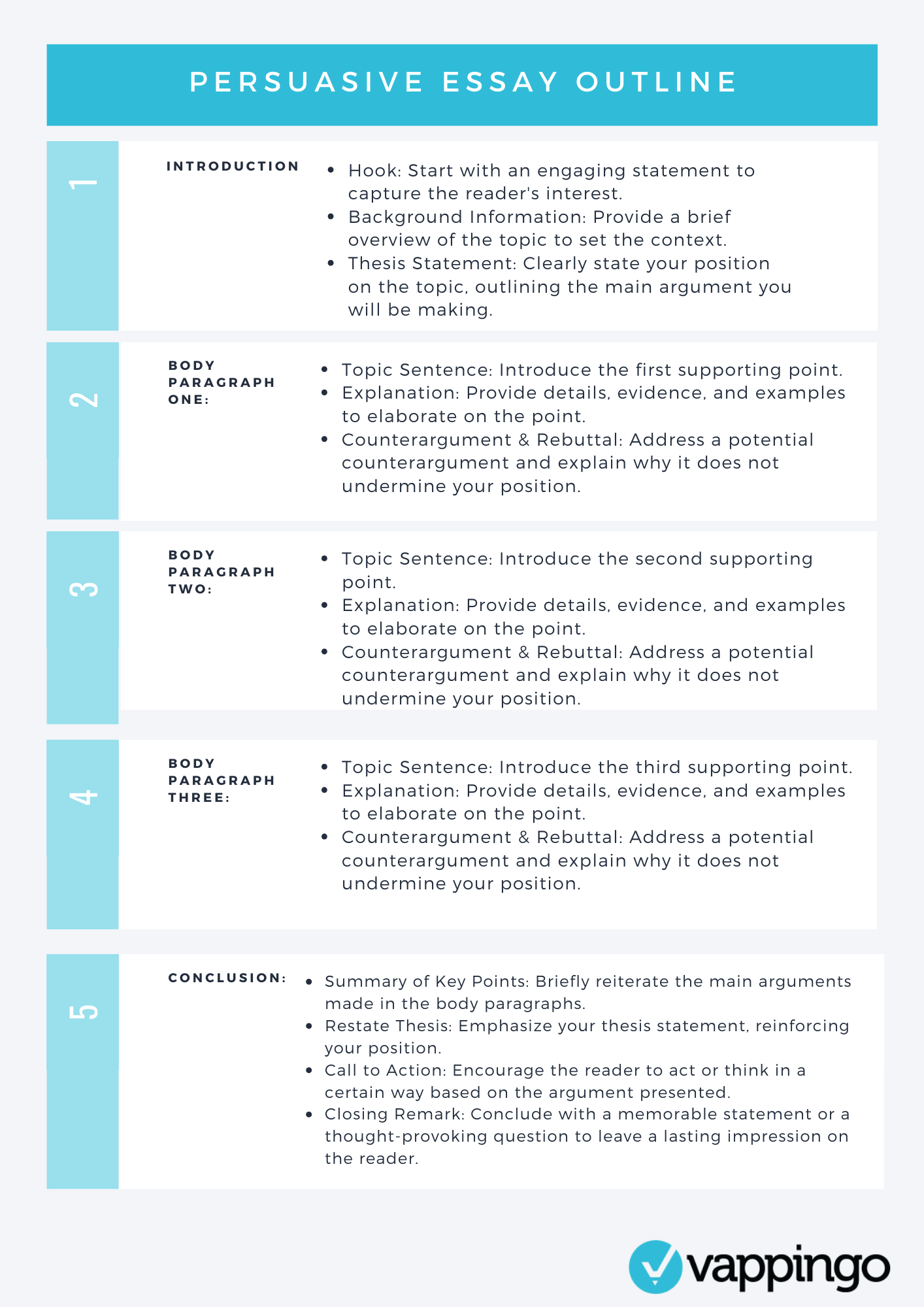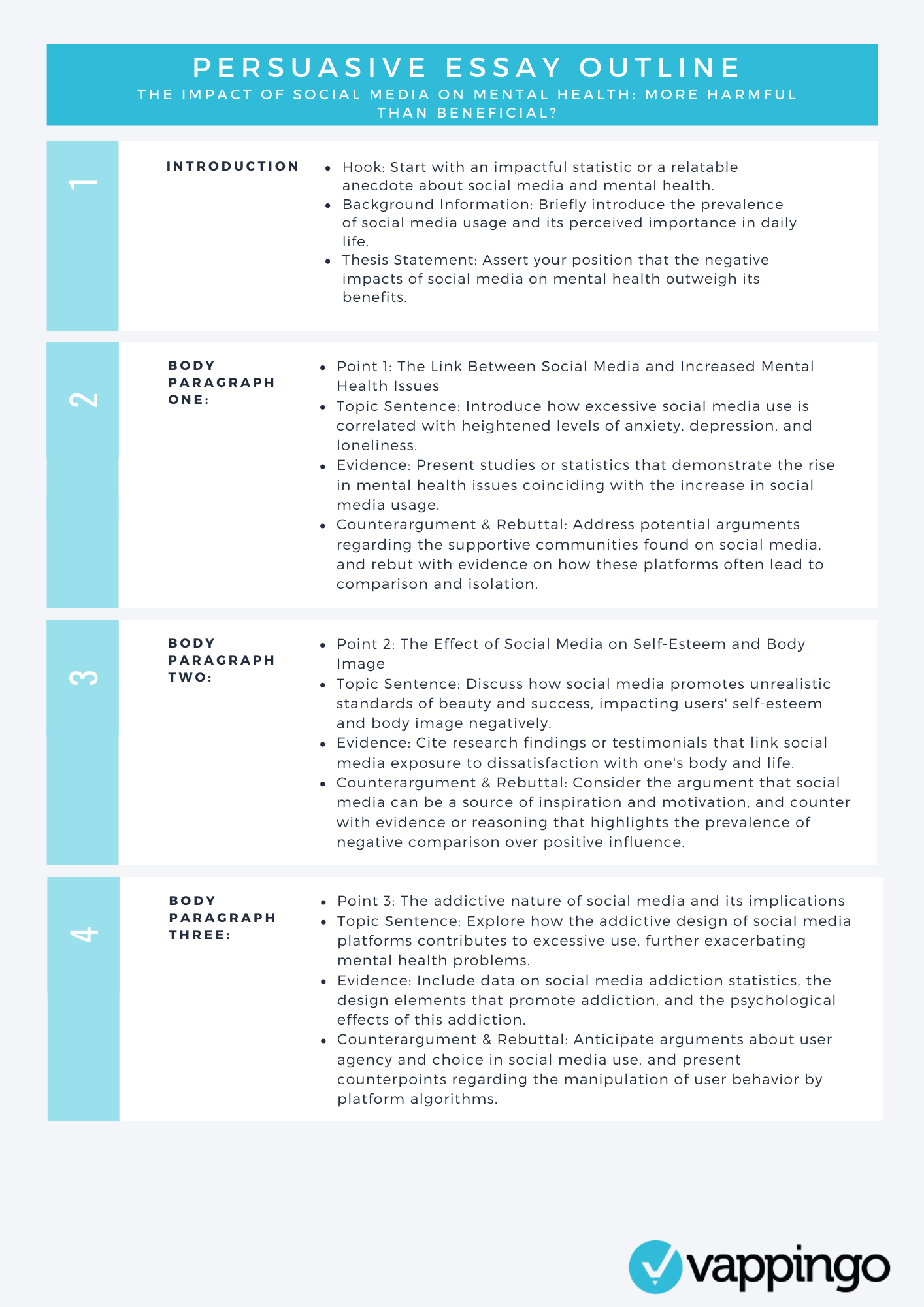A free persuasive essay template and a sample persuasive essay plan to help you get your persuasive essay writing process off to the perfect start.

If you’re a student, you’ve probably faced the daunting task of writing a persuasive essay at some point in your academic journey. While it’s tempting to dive straight into writing, taking the time to plan your essay can save you countless hours of frustration and ensure your arguments are compelling and coherent. Think of your essay outline as a roadmap—it guides you through the persuasive process, helping you navigate from introduction to conclusion with ease.
So, why bother with an outline? Because it allows you to visualize the flow of your ideas, ensuring your arguments are persuasive and well-supported. Without a clear plan, you risk losing your reader’s attention and diluting the power of your persuasion.
My advice? Plan ahead with an essay outline. It’s a simple yet powerful tool that can transform your persuasive writing and make the process much more manageable.
Before you go any further, make sure you are clear on the differences between a persuasive essay and an argumentative essay. If you are writing an argumentative essay, download our argumentative essay plan instead. You’ll also find our examples of argumentative essay topics very useful.
Fortunately for you, we’ve made the planning process much easier with a free persuasive essay template. You can also use our free essay outline generator to create a fantastic essay outline at the click of a button.
Once you have written your essay, be sure to consult the services of a professional essay editor.
Persuasive Essay Template
Click the image below to download your persuasive essay template.
Not sure what to write about? Here’s a massive list of 150 examples of persuasive essay topics.
But how do you create an essay outline? Let’s look at a sample outline for a persuasive essay to demystify the process.
Essay Outline Template for a Persuasive Essay:
Crafting a persuasive essay requires careful planning and strategic organization. Here’s a sample outline to help you structure your persuasive arguments effectively:
Introduction:
- Hook: Grab the reader’s attention with a compelling opening statement or question
- Background Information: Provide context for your topic and establish its relevance
- Thesis Statement: Clearly state your position and preview the main arguments to follow
Body Paragraphs:
- Argument 1:
- Supporting Evidence: Present facts, statistics, or examples that support your argument
- Counterargument: Address potential objections or opposing viewpoints
- Rebuttal: Refute counterarguments and strengthen your position
- Argument 2:
- Supporting Evidence: Provide additional evidence to bolster your argument
- Counterargument: Acknowledge opposing perspectives and address them thoughtfully
- Rebuttal: Strengthen your argument by debunking counterarguments
- Argument 3:
- Supporting Evidence: Offer compelling evidence to reinforce your stance
- Counterargument: Anticipate objections from skeptics and address them convincingly
- Rebuttal: Strengthen your argument by undermining opposing viewpoints
Conclusion:
- Restate Thesis: Recap your main argument and reiterate your position
- Call to Action: Urge readers to take a specific action or adopt your viewpoint
- Final Thought: Leave readers with a memorable takeaway or thought-provoking question
Example Completed Persuasive Essay Outline
Here’s an example of a completed persuasive essay outline for a persuasive essay on the topic of “The Benefits and Drawbacks of Social Media Usage Among Teenagers.”
Sample Persuasive Essay Plan
Introduction:
- Hook: Begin with a thought-provoking statistic or scenario highlighting the prevalence of social media among teenagers.
- Background Information: Provide context on the widespread use of social media platforms and their impact on adolescent behavior and well-being.
- Thesis Statement: Argue that while social media offers numerous benefits for teenagers, it also presents significant drawbacks that must be addressed through informed usage and regulation.
Body Paragraphs:
- The Positive Impacts of Social Media
- Supporting Evidence: Present research findings on how social media facilitates communication, fosters social connections, and provides access to diverse perspectives.
- Counterargument: Acknowledge concerns about the potential for social media addiction and negative online interactions.
- Rebuttal: Highlight the positive aspects of social media, such as its role in promoting activism, raising awareness, and facilitating creative expression.
- The Negative Effects of Social Media
- Supporting Evidence: Discuss studies linking excessive social media usage to mental health issues, such as depression, anxiety, and low self-esteem.
- Counterargument: Consider arguments suggesting that social media can enhance self-expression and provide a platform for marginalized voices.
- Rebuttal: Emphasize the need to address cyberbullying, privacy concerns, and the addictive nature of social media platforms to mitigate their harmful effects on teenagers.
- Strategies for Responsible Social Media Usage
- Supporting Evidence: Present recommendations for parents, educators, and policymakers to promote healthy social media habits among teenagers.
- Counterargument: Address skepticism about the effectiveness of parental supervision and school-based interventions in regulating social media usage.
- Rebuttal: Advocate for comprehensive education on digital literacy, online safety, and critical thinking skills to empower teenagers to navigate social media responsibly.
Conclusion:
- Restate Thesis: Recap the dual nature of social media as both a valuable tool and a potential source of harm for teenagers.
- Call to Action: Urge stakeholders to collaborate in promoting balanced and responsible social media usage among teenagers through education, regulation, and community support.
- Final Thought: Encourage readers to reflect on their own social media habits and consider the broader implications of digital technology on adolescent well-being and society.
Sample Persuasive Essay Outline
Click the image below to download you persuasive essay sample outline.
This outline provides a structured framework for exploring the complex topic of social media usage among teenagers, highlighting both its benefits and drawbacks. By presenting evidence-based arguments and addressing potential counterarguments, the essay can effectively persuade readers to consider the nuanced impact of social media on adolescent development and advocate for responsible digital citizenship.
In essence, your essay outline serves as a blueprint for crafting a persuasive argument—one that captivates readers’ attention, addresses objections, and leaves a lasting impression. By following this template and example outline, you’ll be well-equipped to craft compelling persuasive essays that sway hearts and minds.
So, the next time you’re faced with the challenge of writing a persuasive essay, don’t underestimate the power of careful planning. With a well-crafted outline by your side, you’ll be well on your way to writing essays that inspire action and change.


